A marshy expanse of wetlands where
plovers, sandpipers, dowitchers, and yellowlegs scurried across the damp sands
at low tide, feeding, while bitterns stood like frozen sentinels, awaiting
their prey, and mallard ducks and wild swans glided in the shallows, and eagles
and osprey soared overhead, and the skies were darkened in season by migrating
flocks of wigeons, oldsquaws, and mergansers.
Estuaries teeming with mussels and clams and periwinkles, and oysters in
great numbers, some large, some small and sweet, all of them inducing visions
of tasty meals. And beyond the
shoreline, low hills and towering forests of oak and chestnut and maple with strawberries
in the spring, blackberries and raspberries in summer, and in the autumn apples
and walnuts and wild grapes. Moving
furtively in the brush were deer and wild turkeys, as well as raccoons and
otter and quail and, lurking in dark wooded fastnesses, mountain lions and
black bears and wolves. The air was
clean, the land was lush and green.
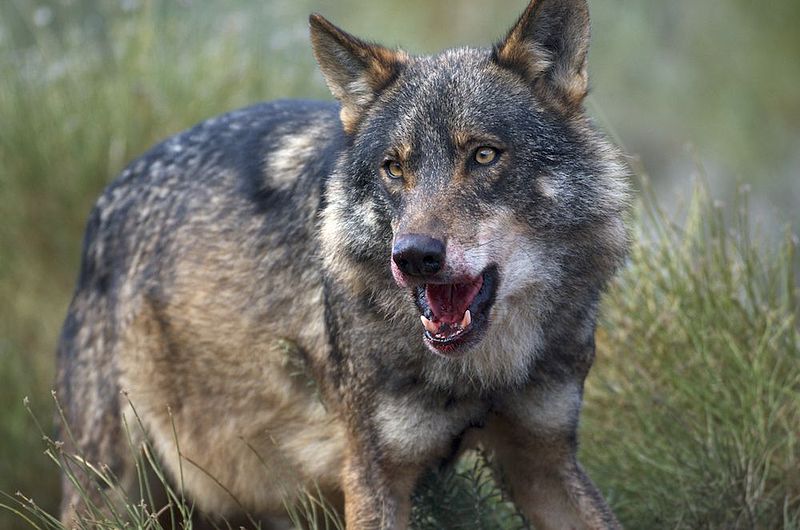 |
| Arturo de Frias Marques |
A glossy ad luring visitors to some
distant, unspoiled Eden, a travel agent’s spiel replete with cooked-up, frothy
vistas no place on earth could match?
No, simply a realistic description of Manhattan in the early 1600s, when
the first European settlers arrived.
And today?
I’ll spare you the obvious litany of cluttered urban woes, the cliché
depiction of a cacophonous wilderness of asphalt, concrete, steel, and cement. But if you look about and look close, you’ll
find that, miraculously persisting, there is still a wild New York. And I don’t mean teen-age gangs, madcap
cyclists, screeching ambulances, or the naked cowboy or bare-breasted cuties exposing
themselves to tourists in hopes of tips in Times Square. I don’t mean homo sapiens sapiens in any
form, but real, wild, living creatures.
 |
| jeremy Seto |
Let’s start with a celebrity predator
known to thousands. I mean, of course,
Pale Male, a red-tailed hawk whose neck is unusually light in color, giving him
his name. He first appeared in the Park
in 1991, and since then has nested each spring with his mate of the moment in
ornamental stonework high atop a residential building at Fifth Avenue at 74th
Street, just across from Central Park.
Pale Male’s marital adventures have always been observed from far below
by a throng of eager fans watching anxiously with binoculars and telescopes to
see if the young will hatch and survive, as many have done, leaving the nest to
reside in Central Park. Pale Male’s
consorts have a way of disappearing, often as a result of eating a poisoned
pigeon or rat, but Pale Male survives, always taking a new mate that his fans
immediately christen: First Love was followed by Chocolate, who was followed by
Blue, then Lola, then Lima, then Paula, then Zena, then Octavia, and so it
goes.
| Courtesy of PaleMale.com |
If I say Pale Male is known to thousands,
I’m not exaggerating, for he has been the subject of a one-hour documentary
film and a book. An aging stud, he is
the first hawk known to have nested in the city, and his fans are fiercely
loyal. In December 2004, when the board
of the co-op where he nested removed the hawks’ nest and the anti-pigeon spikes
anchoring it, their action provoked an international outcry. The Audubon Society and the Central Park
birdwatching community protested; TV celebrity Mary Tyler Moore, a resident of
the building, joined the protest; the media reported the outrage; and passing
automobiles, taxis, and even police cars sounded their horns in solidarity. A compromise was reached, a new cradle for
the nest was installed, and the hawks began bringing twigs to the nesting site.
The red-tailed hawk, the common resident broad-winged
hawk of this area, is a thick-set bird with a wide, rounded tail; it is often
seen soaring in circles high above the city. Seen from below, the tail is dark gray, but if
seen from above, it is red, giving the hawk its name. I have seen Pale Male only in film, perched
with his mate on his nest, where the scrawny young squirmed and bustled, but I have spotted other
red-tails perched in trees in Pelham Bay Park.
Red-tails have been known to nest
on other tall buildings in the city, though none can match Pale Male for
persistence and longevity. That the
species nests at all in New York is an amazing feat of adaptation, given the
numerous threats to it posed by the urban environment: poisoned prey, aggressively
hostile crows, and when the hawks swoop low, risk of collision with passing
vehicles.
 |
| A red-tailed hawk. Don DeBold |
Pale Male is the only creature in this
area I know of that has attained celebrity status; other denizens of New York
habitats creep, skulk, or soar in anonymity.
All the big parks harbor a surprising number of species, and Central
Park is second to none. Prowling there
by day in the spring, I have seen migrating birds by the score and even
occasionally by the hundred in a single day, as well as hordes of termites
hatching from decaying logs – a sight welcome to birdwatchers, since it brings
hungry warblers down to eye level, as they feast on their teeming prey.
 |
| Eastern screech owl. The screech is more of a mournful whinny or wail. Wolfgang Wander |
But Central Park by night is another
story. Years ago, crossing it at night at
72nd Street to attend a poetry workshop on the Upper East Side, I
treaded with trepidation, for the city
then was rife with crime, streetlamps along my way were few, and my footsteps
clicked on the pavement, announcing my presence to any nearby malefactors; the
one bit of reassurance was a squad car parked halfway cross the park, Today, however, crime has declined, and venturing
into the park at night has become the preferred pastime of a number of hardy
and inquisitive souls. A Russian lady in
an electric cart comes there nightly to feed peanuts to a bunch of rambunctious
raccoons (against park regulations, I’m sure).
Owl watchers have a only a precious half hour to spot screech owls,
somnolent by day but on the hunt by night, before the gathering darkness
renders them invisible. And “mothers”
(rhyming “authors”) gather at the Shakespeare Garden to attract moths with a special
battery-powered light, so they can marvel at the weird and spectral beauty of
these rarely seen nocturnal creatures.
(Once, on a tree trunk at High Rock Park on Staten Island, I was
privileged to see a sleeping luna moth by day and marveled at its lime-green
wings with eyespots and, yes, its weird
and spectral beauty.) For all these
visitors Central Park by night has a magic all its own, and they revel in its
sounds: hoots and rasps of owls, yips of raccoons, and in dead leaves the
rustle of white-footed mice.
 |
| A luna moth. |
When not being fed by the Russian lady,
Central Park raccoons – there are some 50 of them -- invade the trash cans by
night to feed voraciously. Black-masked
with striped, bushy tails, they are tough customers that other animals prefer
not to mess with. I have seen them sleeping
tranquilly by day in trees, but raccoons from Central Park have invaded West
Harlem, prowling there by day, crawling over fences from one backyard to
another, and even invading homes to the point where terrorized residents have
pleaded with the city for help.
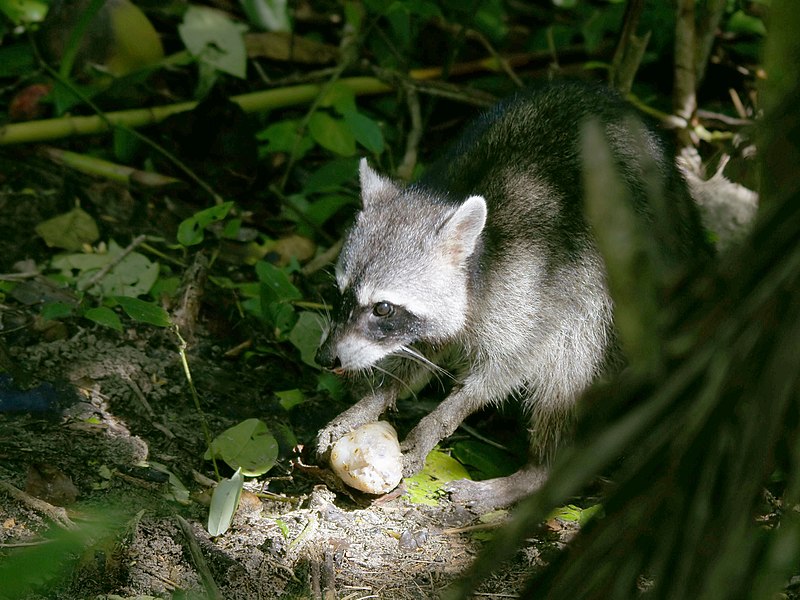 |
| A raccoon, having a meal. Hans Hillewaert |
These
guys also raided a henhouse in Brooklyn and killed all the hens, and even tried
to do in the rooster as well. And in
September 2014 a raccoon broke into a Bronx beauty shop and ran rings around
the cops trying to capture it, leading them a merry chase that onlookers
outside watched with amusement, until the officers finally managed to lock the
intruder in a cage. These furry
creatures thrive now in suburban and urban sites because they are amazingly
adaptable and, like people, will eat almost anything. They are not to be messed with casually
since, if cornered, they fight viciously, have sharp teeth that bite, and can
carry rabies. Exterminators in the area,
usually busy eliminating roaches, mice, and bedbugs, now advertise raccoon
removal services as well. Yes, right
here in New York – aggressive raccoons!
 |
| They do get around. Carsten Volkwein |
Less pushy and obstreperous is another
Central Park resident, the Virginia opossum, a cat-sized marsupial with a
pointy white face that emerges at night to feed on slugs, grasshoppers,
caterpillars, snakes, mice, bird eggs, acorns, berries, grass, and dead animals
– just about anything smaller and slower than itself. When threatened, this sly character “plays
possum” by rolling over in a deathlike trance, eyes closed, tongue protruding,
until the threat is gone, at which point the opossum revives miraculously and
resumes its slow nocturnal hunt for food.
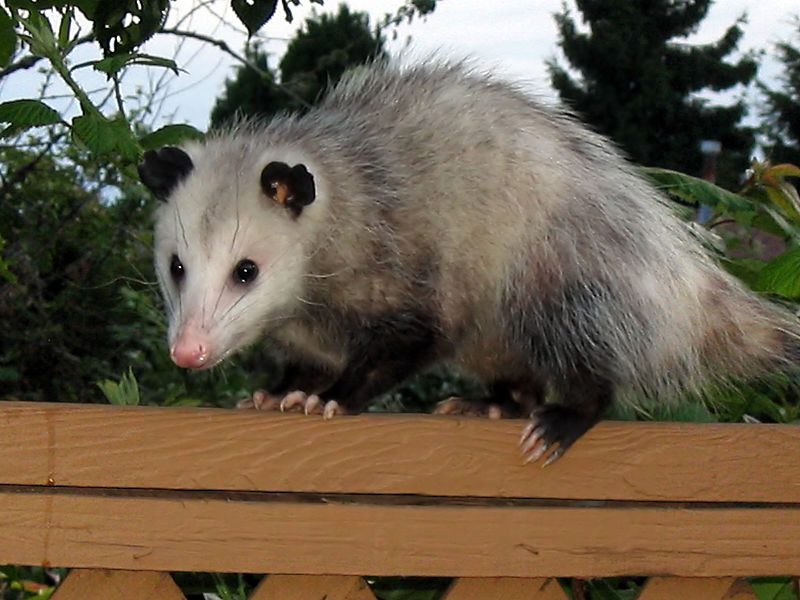 |
| Virginia opossum. Drcyrus |
Also seen in Central Park at night are at
least five species of bats, one of which, the little brown bat, I once saw zoom
low over the Loch, a winding watercourse in the North End of the Park. I might have thought it a bird, but there was
something weird about its lightning-fast flight over water, and another
birdwatcher identified it for me. Had I
seen it clinging to a tree, I would have found it eerie, for this long-eared
little creature has long, spiky fingers that support the wings, giving it a
demonic appearance. Few would call it –
or any bat – beautiful, but we should be thankful for their presence, since one
bat can eat 500 mosquitoes in an hour.
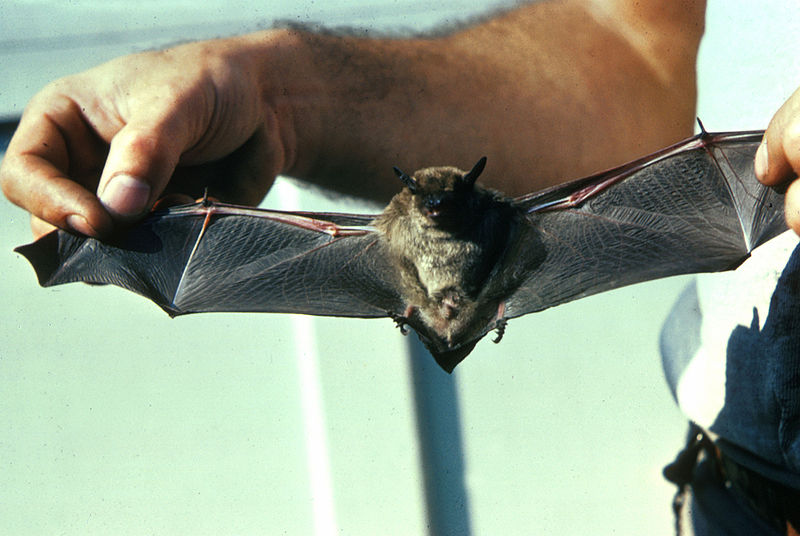 |
| Little indeed, but eerie. |
Other residents of the Park include the
Eastern chipmunk, the gray squirrel, wasps, hornets, slugs, snails, frogs,
clams, and – appropriately in the Turtle Pond – three species of turtles. But that is hardly the whole story. An intensive 24-hour
“BioBlitz” by scientists and volunteers in the summer of 2008 recorded 836
species in the Park, including 393 species of plants, 102 invertebrates, 78
moths, 46 birds, 10 spiders, 9 dragonflies, 7 mammals, 3 turtles, 2 frogs. Regarding the birds, 46 species is minimal;
during spring and fall migrations they would have found hundreds more. But some species found in the Park until
recently have disappeared: the woodchuck and the Eastern cottontail, both of
which I have seen elsewhere.
Not reported in Central Park but seen in
Van Cortlandt Park in the Bronx, and in Alley Pond Park in Queens, is the red
fox. I have heard of sightings in Van
Cortlandt over the years, but on my many hikes there I have never seen one, and
for good reason: they are nocturnal and, unlike the raccoon, very shy. They too eat just about anything – mice,
shrews, moles, squirrels, rabbits, opossums, even those obstreperous raccoons,
as well as turtles, lizards, snakes, and insects, and for a vegetarian option,
acorns, cherries, berries, grapes, and nuts.
When, rarely, they are sighted, it’s usually a quick flash of red and
they are gone.
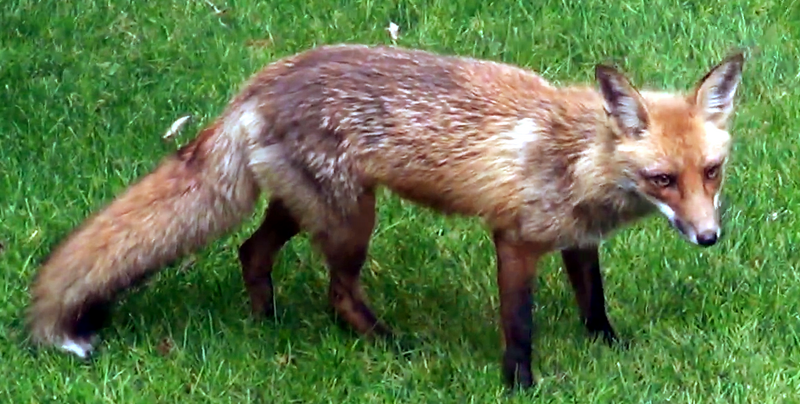 |
| A red fox, photographed in the photographer's back yard. |
Also not seen as yet in Central Park but
appearing elsewhere is another newcomer, the coyote. Yes, we tend to associate the coyote with
cowboys, Big Sky, and the shootout at the O.K. Corral, but the Eastern coyote,
as its name implies, resides here in the East and has been extending its range
southward to include the New York metropolitan area. Sneaking in from Westchester County just
north of the city, it has now made its home for several years in parks in the
Bronx and Queens, where residents rarely see it, but hear its howls at night
and find their trash cans raided. And if
they do see it, they often mistake it for a dog.
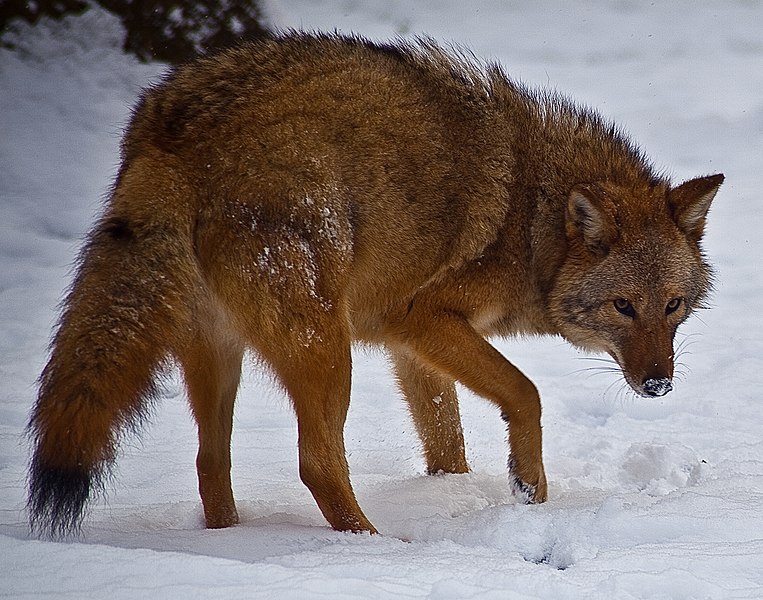 |
| Looks like a wolf, but it isn't. Looks like a dog, but it isn't. ForestWander |
When coyotes first arrived in New York
State is hotly debated. Some think they
were here before European settlers arrived, and scattered to wilderness areas
as woodlands were cleared for farms, then returned when farms reverted to
forest. But others think they are new to
the state, moving in from central North America only after settlers eliminated
the wolf. They were first observed in
northern New York in the 1930s, and by the 1980s had spread throughout the
state. In 1994 one appeared in Woodlawn
Cemetery in the Bronx – its modern New York City debut – and another was
spotted a year later in Van Cortlandt Park.
That coyotes should appear in the northern
outer boroughs was not altogether surprising, since those areas had large
parks, and freestanding houses with yards and alleys with trash cans that could
easily be raided. But Manhattan, with
its congestion, its busy streets, its noise, and its close-packed buildings,
seemed an unlikely habitat for these skulking nocturnal scavengers. Until, that is, one crossed into the borough
in 1999, probably following a train line, and another was spotted in 2010 at
the Manhattan entrance to the Lincoln Tunnel – events that provoked a great
media brouhaha, with helicopters tracking the intruders and videos of their
capture circulating on the Internet. And
the invasion continues. Last January a
coyote was captured by the police on a basketball court after midnight in
Riverside Park on the Upper West Side, and two weeks later another was captured
in the residential complex known as Stuyvesant Town on the East Side of
Manhattan.
Recognizing that coyotes are here in the
city to stay, the Parks Department has posted tips for coexisting with the
creatures:
· Don’t feed them
· Store food and garbage in animal-proof containers.
· Keep pets on a leash, since coyotes have been known to
kill them .
· If a coyote approaches you, “act big and make loud
noises.”
Wild coyotes are wary of humans, making
sightings rare. But 2015 has proven to
be a breakout year for the species, with numerous sightings in the suburbs, and
killings of cats and small dogs. There
are reports too of citizens fighting off coyotes with snow shovels, of pet dogs
being snatched off front porches in broad daylight, and even – rarely – of a
coyote biting a suburbanite who may then have to have a series of rabies
shots. These events are more common in
wooded suburban areas than in the city, but there have been plenty of sightings in the
city too, including a coyote that got onto the roof of a bar in Queens. But never fear, the cavalry are coming. Well, maybe not cavalry, but the Police department’s
Emergency Services Unit who, armed with tranquilizer guns and guided by a
helicopter, chased a coyote through Riverside Park last April, only to have it
escape, and who, days later, pursued a coyote through Battery Park City,
cornered it in the outdoor seating area of a café, and stunned it with a
dart. A photo of the caged victim was
then triumphantly posted on Twitter, and its fate announced: release “into an
appropriate wilderness area.” But first,
one official announced, it would be interrogated … by a police dog, of
course. So it goes in urban New York. Which suggests a new version of a
time-honored rhyme:
Ashes
to ashes,
Dust
to dust,
If
raccoons don’t get you,
Coyotes
must.
Coyotes are relative newcomers to the
city; by way of contrast, the city has always been besieged by rats. While waiting for a subway train, if you
glance down at the rubbish-strewn tracks, sooner or later you are bound to see
their fat brown bodies skulking about, eating what New Yorkers – some of us –
cast so cavalierly down on the tracks.
There are an estimated 2 million of them in the city (some would say
more), averaging some 16 inches long and weighing 1 pound, though they have
been known to measure up to 20 inches and weigh 2 pounds. Fat as they are, they can squeeze through tiny
holes, leap 4 feet sideways, fall 5 stories without injury, and tread water for
3 days. Other accomplishments include
the ability to chew through pipe, have a new litter every 2 months, carry
pathogens that cause various illnesses, invade restaurants after hours, and
crawl up sewer pipes to enter apartments through toilets. They have bitten infants and the homeless and
have eaten corpses in the city morgue.
Obviously, not the most desirable of neighbors. Is it any wonder that all 109 of the city’s mayors,
almost without exception, have announced plans to eradicate this scourge, or
that the scourge persists?
 |
| Just where you'd expect him: in the subway. m01229 |
At this point, this post has probably
discouraged numerous potential visitors from setting foot in New York. And yet, having lived here for decades, I
myself have seen rats only on subway tracks.
Restaurants I have patronized have on occasion been closed temporarily
because of infestations, and the parks I frequent often have signs posted,
warning that rat poison has been spread there recently – a danger more to pets
than to me. My building’s garbage cans
are usually tightly sealed, though on occasion the trash they contain overflows;
but so far, no rats. So I survive: in my
personal experience, no raccoons, no coyotes, no rats. (Just ten thousand roaches.)
 |
| Paul Lowry |
But the war continues. Our mayor, Bill de Blasio, has just included
$2.9 million in the budget for rat control, rats being, in Hizzoner’s words,
“one New York City institution that we’re happy to get rid of.” Inspectors are stalking neighborhoods on the
lookout for signs of rat behavior, teams are being assigned locations, solar
compactors and other rat-proof bins are being supplied to the Sanitation
Department, and relevant city bureaucracies are being told to “think like a
rat.” But the enemy is known to be
diabolically clever, opportunistic, and not fussy when it comes to meals. Good luck, Mr. de Blasio. You’re up against yet another wild critter
that has adjusted marvelously to urban ways and finds a feast in any trash pile,
any garbage can whose lid is not securely fastened. They prosper because, alas, we feed them.
Finally, having just scrutinized the
ground and the sewers, let’s have a look at the skies, where two more large raptors
can be seen soaring overhead. I have
watched a pair of ospreys nesting in spring on a wooden platform built to
accommodate them in Jamaica Bay Wildlife Refuge, sometimes both of them at the
nest, with the scrawny young, beaks agape, just barely visible above the edge
of the nest. And at times I have seen an
osprey soaring, white below, its great outstretched wings marked with dark
wrist patches, its black cheek patch sometimes visible. And once, hiking along the New Jersey side of
the Hudson in November, I saw an osprey with a large fish in its beak, until,
out of nowhere, a bald eagle appeared who grabbed the fish right out of the
osprey’s break and made off with it – all this in a matter of seconds. Ospreys are big, but eagles are even bigger, and
in nature the big guys always win.
 |
| An osprey, extending its talons as it prepares to dive on its prey far below. |
The
other large soaring raptor common to New York is the peregrine falcon, a crow-sized
predator that, liking high cliffs, has adapted to the city, where it perches on
ledges of skyscrapers and on bridges, and from there plummets at a speed of
over 200 miles an hour – the fastest of any animal on earth – to seize a pigeon
or mourning dove that it has spotted far below.
Observed when perched, it shows color ranging from blue-black to slate
gray above, and from white to rusty below with dark markings, its white neck
marked with black cheek patches, or “sideburns.” And they do perch in the city, and not always
at dizzying heights; my partner Bob’s doctor has shown us photographs he took
of a peregrine sitting on top of a lamppost at Union Square.
 |
Male and female peregrine falcons. |
Long before seeing peregrines here in the
city, I used to see them every autumn on Monhegan Island off midcoast Maine,
where birders would come from great distances to watch them soaring or diving
off the cliffs, perhaps feeding on the huge raft of eider ducks that always appeared
there in the fall. One windy day when
there were few birds to see, I went to Blackhead, a headland towering some 150
feet above the sea, where I lay down to get out of the wind, and saw, soaring
far above me, three, then four, then five, six, seven peregrines, riding the
air currents high in the sky. But
there’s no need to go to Maine to see them, since there are more peregrines
here in the city than in any other place in the world, though I can’t promise
seven all at once. To see them diving at
lightning speed, even though it means the death of some smaller bird, is to
witness one of the wonders of nature, sudden, dire, and thrilling.
This post deals with wild animals in the
city, but plenty of wildflowers grow here too, as I have mentioned in other
posts. If, at this time of year, I go
out on errands or for a walk, within two or three blocks I can usually spot at
least five wildflowers, often more. They
grow in vacant lots, in small bits of greenery, out of sidewalk cracks, even
off the sides of old piers, some of them too tiny to be visible from a standing
position; to find them, I squat. Usually
dismissed as weeds, they always excite me (no, not that way), for they are growth, exuberant life, Big Mama. Along with the insects, they will inherit the
earth if we humans ever die out. On this
happy note I’ll end.
WNYC, Goldman Sachs, and Monsanto: Viewers of this blog know the love I bear
Goldman Sachs (expressed fondly in post #158, December 21, 2014) and
Monsanto. They may also recall that, as
a loyal contributor to WNYC, I queried the station to find out if these two
stellar entities were among their contributors.
Months of silence followed, but finally last April I received a
courteous response from the Manager of Listener Services, informing me of the
following:
· Monsanto was once an underwriter of the program “Marketplace,”
but WNYC is confident that Monsanto’s sponsorship of the show played no part in
the news coverage.
· Goldman Sachs is currently an underwriter of the
program “Freakonomics,” but again, WNYC is confident that its coverage is not
influenced by Goldman Sachs’s sponsorship.
I will let the viewers decide
whether or not the station can be blithely indifferent to where its money comes
from. Monsanto and Goldman Sachs know
how to play the game; they put their money where it counts. WNYC’s intentions are no doubt fine, but it
might come down to which stories are not covered, or covered only lightly,
rather than deliberate distortions of the news.
The soundest policy would be to eschew (I love this word; it sounds like
a sneeze) all donations from corporations whose activities are controversial.
Coming soon: Religion in New York. How doughty old Peter Stuyvesant couldn’t
stand Quakers because they quaked.
Today, High Church, Low Church, and No Church. Who’s winning converts, who’s losing? Worshipers speaking in tongues and raising their arms in rapture, and the parishioners who won’t let their church close their
parish. And yes, organized paganism and
some atheist Satanists who want children to be allowed to pray in school … to
Satan. So who said New York is
godless? We’ve got gods and believers all over the place.
©
2015 Clifford Browder

No comments:
Post a Comment